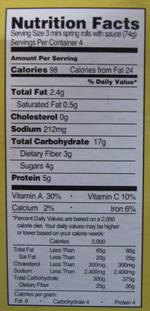Blog
Diet Info labeling
Nutrition Facts labeling

All packaged foods that require a Nutrition Facts label must
list not only the gram weight of various nutrients, but also their Percent
Daily Value (% DV). Companies that
proactively comply with these requirements may reduce the risk and expense of undertaking
corrective measures after packaging has been printed and a product has been
distributed.
What is a Percent “Daily
Value” (DV)?
A Percent Daily Value is the percentage of a nutrient contained
in a serving of food. It is based on a
2,000 calorie daily diet.
How should my
Product’s Package List the Percent DV?
Percent DV information must be listed for nutrients (1) for
which a Daily Reference Value (DRV) or Reference Daily Intake (RDI) has been
established and (2) that must be listed in the Nutrition Facts panel. 21 C.F.R. §§ 101.9(c)(8)(iv); 101.9(c)(9);
101.9(d)(7)(ii); 101.9(d)(8). These
include fat (separately listing saturated fat and cholesterol), sodium,
carbohydrates (which often requires separately listing dietary fiber and sugar),
and other vitamins and minerals. The Percent
DV should be listed as a whole number, and several rules govern how it should
be rounded, depending on the calorie content, serving size, and specific nutrient.
In Addition to the
Percent DV, how should a Package List the Quantitative Measure Of Calories and
Nutrients?
Calories should be rounded to the nearest five- or
10-calorie increment (depending on the total calories). See 21 C.F.R. § 101.9(c)(1). Total fat should be rounded to nearest half
gram (and down to zero if less than half a gram). 21 C.F.R. § 101.9(c)(2). Sodium should be rounded to the closest 5 mg
or 10 mg, depending on the amount contained in the product. 21 C.F.R. § 101.9(c)(4).
Are there Other
Variables to Consider in Calculating and Listing These Nutrition Facts?
Yes. Many variables
govern whether the amount and percentage of various nutrients may or must be identified in or near the Nutrition Facts box. These factors include (but are not limited
to) the type of food, whether the packaging includes nutrient content claims,
and several other variables. For advice
regarding compliance with these regulations, seek qualified legal counsel.
Steven Kronenberg is
the Owner of the Law Offices of Steven Kronenberg in the San Francisco Bay
Area. He advises food processing clients regarding food safety, food quality,
and brand integrity issues, including regulatory compliance, risk management,
and litigation. He can be contacted at
kronenberg@hotmail.com
or through his blog, foodlawblog.com.

